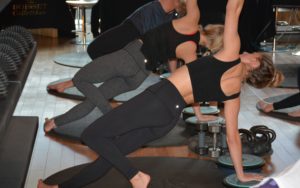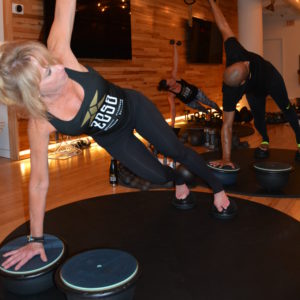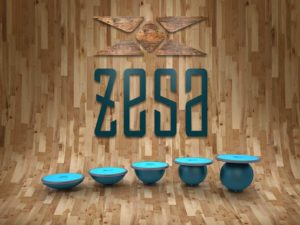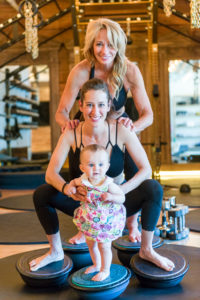HEALTH ISSUES SPECIFIC TO WOMEN
General Health Issues:
-
Due to basic differences in anatomy, women athletes are much more prone to joint related injuries, with ACL injuries being up to 6 times more common among women.[iii]
-
Balance loss begins in our 20’s, amplifies falls and injury probability, and lowers quality of life and longevity unless we counteract it. [i] [ii]
Pregnancy, Pelvic Floor Dysfunction & Urinary Incontinence:
-
Pregnancy and childbirth are a main factor in the development of female pelvic floor dysfunction, which can lead to urinary incontinence.[iv]
-
Low back pain can be a common ailment during pregnancy (up to 50% of pregnant women), having a great impact on quality of life during that time.[v]
-
Lack of exercise and physical activity during pregnancy can lead to a higher risk of pre-eclampsia, hypertension, gestational diabetes and other pregnancy related issues.[vi]
-
Urinary incontinence (UI) is a chronic health condition affecting up to 30% of women over age 20, 50% of women over age 60, and 77% of women residing in nursing homes.[vii] UI is considered an important public health problem for the female population.[viii]
-
UI demands high treatment costs and high rates of sick leave[ix], and negatively impacts woman’s quality of life.[x]
Effects of Aging:
-
Women experience drastic hormonal changes during midlife from menopausal transition which can also lead to pelvic floor dysfunction with symptoms of urinary incontinence and dysfunction of sexual arousal, orgasm and sexual satisfaction.[xi]
-
Menopausal transition also leads to bone loss and decreased lean muscle mass.[xii]
-
Women on average live longer than men, and since age is the biggest risk factor for dementia (especially Alzheimer’s disease), more women are at risk. About ⅔ of those diagnosed with Alzheimer’s are women in the US and worldwide.[xiii]
-
Recent studies show strong correlation between poor balance and higher risk of Alzheimer’s, and poor motor function is an early indicator of the onset of dementia.[xiv]
-
Fall injuries for US citizens = $80 Billion (& rising) in medical costs each year.[xv] Projections show this to increase to over $101 Billion by 2030.[xvi] Studies show that women are more likely to fall than men, leading to a high rate of disability and death from falls.[xvii]
-
Falling once doubles the risk of falling again.[xviii] 50% of aging adults and others who fear falling limit their social and physical activities due to this fear, further worsening their problem.[xix] However, studies show that regular strength and balance training can significantly reduce age-induced neuromuscular risk factors with a fall rate reduction of up to 50%.[xx]
TRAINING SOLUTIONS & HEALTH IMPROVEMENTS FOR WOMEN
General Health Improvements:
-
The ZeSa® Dynamic Balance-Strength Training System™ advances fitness and improves health for women by engaging a variety of dynamic Balance-Strength™ exercises with progressive increasing difficulty.[xxi]
-
The Balance-Strength Analysis™ app provides you an easy method to analyze and track your Balance-Strength™ capabilities and progress.
-


The Balance-Strength Training™ app allows you to carry out pre-made or custom training sessions of your choice to focus on your desired training goals.
-
ZeSa’s system challenges & improves Balance-Strength™ for overall body fitness.
-
Activates all muscle layers for maximum muscle recruitment & joint stabilization to reduce occurrence and severity of injury, improve injury recovery, and reduce incidence of re-injury.
-
Improves quality of life in all stages & increases longevity, and it is easy (but challenging) & fun to use.
Improve Pregnancy, Pelvic Floor Dysfunction & Urinary Incontinence:
-
Regular use improves core and pelvic floor strength[xxii] and urinary incontinence symptoms, [xxiii] [xxiv] joint stabilization for injury prevention, and increased bone density, muscular strength, and lean muscle mass.
-
ZeSa’s system provides non-impact exercise methods to safely improve your core stability and strength and support your body during pregnancy and postpartum recovery.[xxv] [CAUTION: Pregnant women who have not previously exercised, are deconditioned, or have any pregnancy complications should first be evaluated by their OB-GYN physician and follow their recommendations.[xxvi]]
-
Deeply engages and strengthens core musculature for decreased incidence of low back pain during pregnancy, easier labor, shorter labor times and enhanced postpartum recovery time.
-
Babies born to mothers who maintained physical activity during pregnancy are shown to be less agitated and more alert, are self-quieting, are better able to handle the stress of labor, have better neurodevelopmental outcomes, and a decreased risk of developing chronic diseases such as obesity, diabetes, and cardiovascular disease throughout childhood. [xxvii] [xxviii]
Age with Strength, Balance, and Dignity:
-
Improves balance and reduces the risk of falls, which is the leading cause of injury and injury related deaths among older adults, with one study showing a reduction up to 39%.[xxix]
-
A recent study advocates for training programs tailored to enhance reactive balance, as with ZeSa’s system, which can provide sensory neural feedback essential for balance.[xxx]
-
Enhances stability to maintain the ability to move freely and confidently, crucial for daily activities.[xxxi]
-
Improves cognitive function and reduces or slows the risk of cognitive decline and dementia as women age.[xxxii] [xxxiii]
[i] Horak, F. B., & Shupert, C. L. (1994). Role of the vestibular system in postural control. Gait & Posture, 1(2), 99-108. DOI: 10.1016/0966-6362(94)90020-5.
[ii] Lord, S. R., & Menz, H. B. (2000). Visual contributions to postural stability in older adults. Journal of Gerontology: Series A, Biological Sciences and Medical Sciences, 55(8), M489-M494. DOI: 10.1093/gerona/55.8.M489.
[iii] https://www.health.harvard.edu/blog/the-gender-gap-in-sports-injuries-201512038708
[iv] Kamisan Atan I, Zhang W, Shek KL, Dietz HP. Does pregnancy affect pelvic floor functional anatomy? A retrospective study. Eur J Obstet Gynecol Reprod Biol. 2021 Apr;259:26-31. doi: 10.1016/j.ejogrb.2021.01.047. Epub 2021 Jan 27. PMID: 33561585.
[v] Katonis P, Kampouroglou A, Aggelopoulos A, Kakavelakis K, Lykoudis S, Makrigiannakis A, Alpantaki K. Pregnancy-related low back pain. Hippokratia. 2011 Jul;15(3):205-10. PMID: 22435016; PMCID: PMC3306025.
[vi] Moyer C, Reoyo OR, May L. The Influence of Prenatal Exercise on Offspring Health: A Review. Clin Med Insights Womens Health. 2016 Oct 17;9:37-42. doi: 10.4137/CMWH.S34670. PMID: 27777506; PMCID: PMC5075987.
[vii] Curillo-Aguirre CA, Gea-Izquierdo E. Effectiveness of Pelvic Floor Muscle Training on Quality of Life in Women with Urinary Incontinence: A Systematic Review and Meta-Analysis. Medicina (Kaunas). 2023 May 23;59(6):1004. doi: 10.3390/medicina59061004. PMID: 37374208; PMCID: PMC10301414.
[viii] Bedretdinova D, Fritel X, Panjo H, Ringa V. Prevalence of Female Urinary Incontinence in the General Population According to Different Definitions and Study Designs. Eur Urol. 2016 Feb;69(2):256-64. doi: 10.1016/j.eururo.2015.07.043. Epub 2015 Aug 8. PMID: 26259998.
[ix] Milsom I, Coyne KS, Nicholson S, Kvasz M, Chen CI, Wein AJ. Global prevalence and economic burden of urgency urinary incontinence: a systematic review. Eur Urol. 2014 Jan;65(1):79-95. doi: 10.1016/j.eururo.2013.08.031. Epub 2013 Aug 27. PMID: 24007713.
[x] Nyström E, Sjöström M, Stenlund H, Samuelsson E. ICIQ symptom and quality of life instruments measure clinically relevant improvements in women with stress urinary incontinence. Neurourol Urodyn. 2015 Nov;34(8):747-51. doi: 10.1002/nau.22657. Epub 2014 Aug 22. PMID: 25154378.
[xi] Zhuo Z, Wang C, Yu H, Li J. The Relationship Between Pelvic Floor Function and Sexual Function in Perimenopausal Women. Sex Med. 2021 Dec;9(6):100441. doi: 10.1016/j.esxm.2021.100441. Epub 2021 Oct 7. PMID: 34628115; PMCID: PMC8766258.
[xii] Sipilä S, Törmäkangas T, Sillanpää E, Aukee P, Kujala UM, Kovanen V, Laakkonen EK. Muscle and bone mass in middle-aged women: role of menopausal status and physical activity. J Cachexia Sarcopenia Muscle. 2020 Jun;11(3):698-709. doi: 10.1002/jcsm.12547. Epub 2020 Feb 3. PMID: 32017473; PMCID: PMC7296268.
[xiii] https://doi.org/10.1002/alz.13809
[xiv] https://www.thelancet.com/journals/lanhl/article/PIIS2666-7568(24)00049-7/fulltext
[xv] Haddad YK, Miller GF, Kakara R, et al. Healthcare spending for non-fatal falls among older adults, USA Injury Prevention 2024;30:272-276.
[xvi] Houry D, Florence C, Baldwin G, Stevens J, McClure R. The CDC Injury Center’s response to the growing public health problem of falls among older adults. Am J Lifestyle Med. 2016 Jan-Feb; Found on the internet at https://www.ncbi.nlm.nih.gov/pmc/articles/PMC4681302/
[xvii] Stevens JA, Sogolow ED. Gender differences for non-fatal unintentional fall related injuries among older adults. Inj Prev. 2005 Apr;11(2):115-9. doi: 10.1136/ip.2004.005835. PMID: 15805442; PMCID: PMC1730193.
[xviii] https://www.cdc.gov/falls/data-research/facts-stats/index.html
[xix] Jefferis, B.J., Iliffe, S., Kendrick, D. et al. How are falls and fear of falling associated with objectively measured physical activity in a cohort of community-dwelling older men?. BMC Geriatr 14, 114 (2014). https://doi.org/10.1186/1471-2318-14-114
[xx] Sherrington, C., Whitney, J. C., Lord, S. R., Herbert, R. D., Cumming, R. G., & Close, J. C. (2008). Effective exercise for the prevention of falls: A systematic review and meta-analysis. Journal of the American Geriatrics Society, 56(12), 2234-2243. DOI: 10.1111/j.1532-5415.2008.02014.x.
[xxi] Dunsky A. The Effect of Balance and Coordination Exercises on Quality of Life in Older Adults: A Mini-Review. Front Aging Neurosci. 2019 Nov 15;11:318. doi: 10.3389/fnagi.2019.00318. PMID: 31803048; PMCID: PMC6873344.
[xxii] Urs Granacher, Andre Lacroix, Thomas Muehlbauer, Katrin Roettger, Albert Gollhofer; Effects of Core Instability Strength Training on Trunk Muscle Strength, Spinal Mobility, Dynamic Balance and Functional Mobility in Older Adults. Gerontology 1 February 2013; 59 (2): 105–113. https://doi.org/10.1159/000343152
[xxiii] Nipa SI, Sriboonreung T, Paungmali A, Phongnarisorn C. The Effects of Pelvic Floor Muscle Exercise Combined with Core Stability Exercise on Women with Stress Urinary Incontinence following the Treatment of Nonspecific Chronic Low Back Pain. Adv Urol. 2022 Sep 5;2022:2051374. doi: 10.1155/2022/2051374. PMID: 36105867; PMCID: PMC9467742.
[xxiv] https://scholarworks.calstate.edu/downloads/vm40z022c
[xxv] https://www.acog.org/clinical/clinical-guidance/committee-opinion/articles/2020/04/physical-activity-and-exercise-during-pregnancy-and-the-postpartum-period
[xxvi] https://www.acog.org/clinical/clinical-guidance/committee-opinion/articles/2020/04/physical-activity-and-exercise-during-pregnancy-and-the-postpartum-period
[xxvii] Clapp JF 3rd. Exercise during pregnancy. A clinical update. Clin Sports Med. 2000 Apr;19(2):273-86. doi: 10.1016/s0278-5919(05)70203-9. PMID: 10740759.
[xxviii] Moyer C, Reoyo OR, May L. The Influence of Prenatal Exercise on Offspring Health: A Review. Clin Med Insights Womens Health. 2016 Oct 17;9:37-42. doi: 10.4137/CMWH.S34670. PMID: 27777506; PMCID: PMC5075987.
[xxix] Reduces the risk of falls, which are the leading cause of injury and injury related deaths among older adults.
[xxx] Jones R, Ratnakumar N, Akbaş K, Zhou X. Delayed center of mass feedback in elderly humans leads to greater muscle co-contraction and altered balance strategy under perturbed balance: A predictive musculoskeletal simulation study. PLoS One. 2024 May 24;19(5):e0296548. doi: 10.1371/journal.pone.0296548. PMID: 38787871; PMCID: PMC11125460.
[xxxi] Sturnieks, D. L., St George, R., & Lord, S. R. (2008). Balance disorders in the elderly. Neurophysiologie Clinique/Clinical Neurophysiology, 38(6), 467-478. DOI: 10.1016/j.neucli.2008.09.001.
[xxxii] Rogge AK, Röder B, Zech A, Nagel V, Hollander K, Braumann KM, Hötting K. Balance training improves memory and spatial cognition in healthy adults. Sci Rep. 2017 Jul 18;7(1):5661. doi: 10.1038/s41598-017-06071-9. Erratum in: Sci Rep. 2018 Nov 22;8(1):17434. doi: 10.1038/s41598-018-35957-5. PMID: 28720898; PMCID: PMC5515881.
[xxxiii] Rogge AK, Röder B, Zech A, Hötting K. Exercise-induced neuroplasticity: Balance training increases cortical thickness in visual and vestibular cortical regions. Neuroimage. 2018 Oct 1;179:471-479. doi: 10.1016/j.neuroimage.2018.06.065. Epub 2018 Jun 26. PMID: 29959048.
